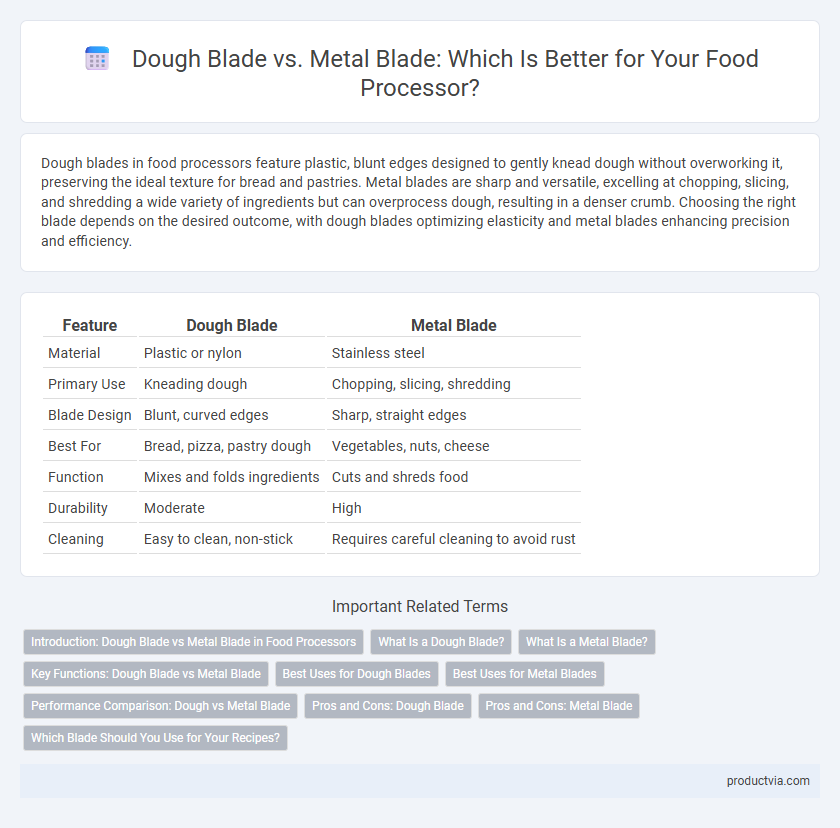Dough blades in food processors feature plastic, blunt edges designed to gently knead dough without overworking it, preserving the ideal texture for bread and pastries. Metal blades are sharp and versatile, excelling at chopping, slicing, and shredding a wide variety of ingredients but can overprocess dough, resulting in a denser crumb. Choosing the right blade depends on the desired outcome, with dough blades optimizing elasticity and metal blades enhancing precision and efficiency.
Table of Comparison
| Feature | Dough Blade | Metal Blade |
|---|---|---|
| Material | Plastic or nylon | Stainless steel |
| Primary Use | Kneading dough | Chopping, slicing, shredding |
| Blade Design | Blunt, curved edges | Sharp, straight edges |
| Best For | Bread, pizza, pastry dough | Vegetables, nuts, cheese |
| Function | Mixes and folds ingredients | Cuts and shreds food |
| Durability | Moderate | High |
| Cleaning | Easy to clean, non-stick | Requires careful cleaning to avoid rust |
Introduction: Dough Blade vs Metal Blade in Food Processors
Dough blades in food processors are specifically designed with plastic or nylon materials to knead and mix dough efficiently without overworking the gluten. Metal blades, often stainless steel, excel at chopping, slicing, and pureeing ingredients with sharp, precise edges suitable for a wide range of food preparation tasks. Choosing between a dough blade and a metal blade depends on the intended use, where dough blades optimize dough consistency while metal blades offer versatility for chopping and blending.
What Is a Dough Blade?
A dough blade is a specialized attachment for a food processor designed specifically for kneading and mixing dough without cutting or shredding the ingredients. Unlike metal blades, which are sharp and used for chopping, slicing, or shredding, dough blades are usually made of plastic with blunt edges to gently combine flour, water, and yeast for optimal dough texture. This design prevents over-processing, ensuring the dough develops proper gluten structure and elasticity essential for baking.
What Is a Metal Blade?
A metal blade in a food processor is typically made of stainless steel, designed for versatile functions such as chopping, slicing, and shredding various ingredients. Unlike dough blades, which are plastic and specifically shaped for kneading dough without over-processing, metal blades provide sharper, more precise cuts for harder or more fibrous foods. Their durability and multi-functionality make metal blades essential for general food preparation tasks.
Key Functions: Dough Blade vs Metal Blade
The dough blade in a food processor is designed specifically for mixing and kneading dough, featuring plastic or nylon construction that prevents over-processing and preserves dough texture. Metal blades, usually stainless steel, excel at chopping, slicing, and shredding a variety of ingredients with sharp edges for quick, precise cuts. Choosing between a dough blade and a metal blade depends on the task: dough blades optimize elasticity and consistency for bread or pizza dough, while metal blades maximize versatility for general food preparation.
Best Uses for Dough Blades
Dough blades in food processors are specifically designed for kneading and mixing heavy doughs like bread, pizza, and pastry, providing uniform consistency without overworking the mixture. Unlike metal blades, dough blades have a blunt, plastic design that prevents cutting through ingredients, which is essential for developing gluten structure in dough. They are ideal for tasks requiring gentle folding, making them the best choice for preparing yeast doughs and other dense mixtures.
Best Uses for Metal Blades
Metal blades in food processors excel at chopping, slicing, and shredding hard vegetables, nuts, and cheese with precision and speed. Their sharp, durable edges make them ideal for tasks requiring fine dicing and smooth purees, outperforming dough blades in versatility. Metal blades are essential for preparing ingredients for salads, sauces, and soups, providing consistent, uniform cuts.
Performance Comparison: Dough vs Metal Blade
Dough blades are designed with plastic, blunt edges to knead and mix dough gently without over-processing, preserving the gluten structure essential for optimal rise and texture. Metal blades feature sharp, stainless steel edges that excel at chopping, slicing, and pureeing but can overwork dough by cutting through gluten strands, resulting in denser baked goods. Performance-wise, dough blades deliver consistent, tender dough ideal for bread and pastry, while metal blades provide versatility for general food prep but are less effective for proper dough development.
Pros and Cons: Dough Blade
Dough blades in food processors feature plastic construction designed specifically for kneading dough without overworking the batter, reducing heat buildup and preserving gluten structure. They are ideal for mixing bread and pizza dough but lack the sharpness necessary for cutting or chopping tasks, limiting their versatility compared to metal blades. However, dough blades reduce the risk of damaging soft ingredients and are gentler on motor strain during prolonged use.
Pros and Cons: Metal Blade
Metal blades in food processors offer superior versatility, efficiently slicing, chopping, and shredding a wide range of ingredients with sharp, durable edges. Their stainless steel construction resists corrosion and maintains sharpness longer, making them ideal for frequent use and tough tasks like cutting nuts or hard vegetables. However, metal blades may over-process delicate dough, causing overheating and potential damage to gluten structure, which makes them less suitable for dough preparation compared to dough blades.
Which Blade Should You Use for Your Recipes?
Dough blades in food processors are designed with plastic, blunt edges to gently knead dough without overworking it, making them ideal for bread, pizza, and pastry recipes. Metal blades, made of sharp stainless steel, excel at chopping, slicing, and pureeing ingredients, providing versatility for sauces, vegetables, and nuts. Choosing between dough blade and metal blade depends on your recipe's requirements: use the dough blade for mixing and kneading dough, while the metal blade suits tasks that require precision cutting and blending.
Dough blade vs Metal blade for food processor Infographic

 productvia.com
productvia.com